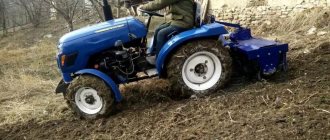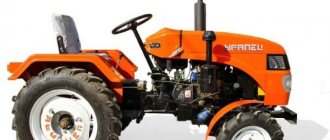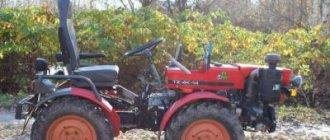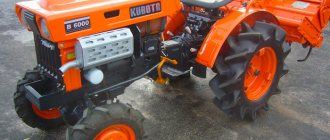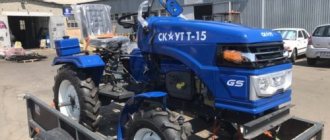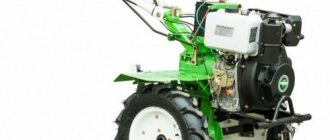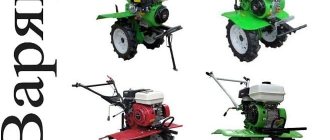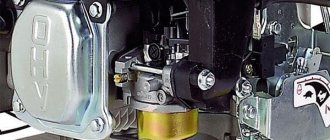During the Soviet era, great importance was attached to the development of agriculture. More and more areas were plowed under crops, and new territories were developed for growing crops.
Such vigorous activity required the use of powerful technology, which mechanized human labor and increased productivity. With the collapse of the Soviet Union, everything changed, the country followed the path of private entrepreneurship.
The requirements for technology have also changed: using powerful tractors on small farms is not economically profitable.
Therefore, the market is flooded with mini-tractors produced in Europe and China. Domestic enterprises simply had nothing to oppose such an influx of small-sized machines.
Currently, Russia is developing this market segment, confidently competing with Western manufacturers. One of the brightest representatives of the Russian family of compact cars is the Uralets mini-tractor, which we will get acquainted with in this article.
Description
Mini tractors of the Uralets brand are today indispensable assistants both on private estates and on small farm enterprises. The machines are manufactured in the city of Yemanzhelinsk (Russia), but despite this, most of the mini tractor parts are supplied from China. The company offers a choice of 10 universal mini tractors, as well as a variety of mounted and trailed equipment, including its own production.
Minitractor Uralets XT-180
Uralets mini tractors are designed to perform a number of jobs in municipal, cleaning and agricultural fields.
Features of the Uralets mini tractor:
- Compact and versatile;
- Economical fuel consumption;
- Electric starting system and high-capacity battery;
- Rear axle differential lock;
- Balanced design;
- Electric starter allows adaptation to low temperatures;
- Diesel engine equipped with a water cooling system;
- Reinforced power take-off shaft, so you can use attachments from other manufacturers.
Inherited from the “three-ton”
UralZIS-355M is a subsequent modification of the ZIS-5 truck, the famous “three-ton truck”. During the war years, production of the ZIS-5 was transferred to the UralZIS plant in Miass (many factories were named after Stalin at that time - such a time). The machine that began to be produced here was called UralZIS-5.
This name was stamped on the frame of the radiator grille, and not just “ZIS” - as on Moscow cars. The next modification was UralZIS-355. It retained the general appearance of the military ZIS-5V, but acquired rounded metal wings. But still, it was a car with a square wooden cabin with a carrying capacity of 3 tons and, in fact, with the same engine. But the next variation - UralZIS-355M - (the letter “M” means “modernized”), while maintaining similar units, looked more modern in appearance thanks to the metal cabin, which has a more rounded shape.
The cabin itself was unified with the GAZ-51 truck - in its second variation (in the early GAZ-51 the cabin was wooden, in later ones it was metal, but with wooden doors). In the future, the GAZ-51 will receive metal doors, and the Ural-ZIS will remain with wooden doors until the end of its production. In 1961, the plant was renamed UralAZ-355M - for all known political reasons. This name is stamped on the side of the hood of the car that became the hero of our article today.
The right front wheel disk is the only “original” one preserved on the car
The lineup
Today, four modifications of our own Uralets equipment are offered. The Uralets-160 minitractor is the first and lightest machine among all Ural vehicles. The engine power is only 16 horsepower, which in most cases is an advantage when processing crops (minimal soil damage). Model 160 is designed for use on small farms and is highly maneuverable.
Minitractor Uralets-160
Uralets-180, in comparison with the previous version, has a more powerful 18-horsepower four-stroke diesel engine with water cooling. Please note that the tractor is not designed to operate heavy equipment; it is not even permissible to install them. The Uralets-220 has the greatest power and thrust. The Uralets-224 tractor is an improved modification of the Uralets 220. A special feature of the machine is the differential lock, as well as the possibility of separate braking.
Jinma tractors are produced jointly with Chinese production.
Minitractor Jinma 244 with cabin
Minitractor Jinma Uralets 244
The Jinma-244 station wagon is an all-wheel drive budget model, used in the agricultural, public utilities and construction sectors. If necessary, the minitractor can be improved by installing a sealed cabin.
A more powerful model is the Jinma-264E (Jinma-264E). This is an all-wheel drive tractor with a 3-cylinder liquid-cooled diesel engine.
People's love
The car didn’t get much fame: there’s no point in bragging about a new modification of an aging truck. But the Ural drivers loved it - they still have a good memory of the car.
Experienced drivers say that the car was very easy to repair and maintain, the car was obedient to drive, strong and durable, with good maneuverability - it drove even on very bad roads. Like no other Soviet car, the Uralets was not afraid of overloads: officially it was 3.5 tons, but it could carry double loads without fear, and on a good road the car could pull triple loads. Shaking and dirt were tolerated calmly: the UralZIS-355M ran briskly both on roads and off-roads with a trailer - the truck was almost never used without it, while the much more modern GAZ-53A was almost never used with trailers.
And in the cabin there is an unprecedented joy - a heater. Cars began to be equipped with them regularly from the very first copies, which cannot be said about either the GAZ-51 or the ZIS-150. The Likhachev plant mastered heating in March 1958 - already on ZIL-164. Heated GAZ-51A appeared earlier, at the end of 1956, but most cars did not have “stoves”.
The weak point of the truck is called the rear axle axle shafts - they did not pull the load beyond the norm. Only Soviet drivers cannot be frightened by such a trivial breakdown: this is not an “engine”, which if it stops, then that’s it - drag it to the garage. Well, we carried a couple of axle shafts with us - in half an hour, if something happened, they changed them.
The rear axle is similar to the ZIS-5 axle, but has a reinforced gearbox
Attachment overview
Uralets mini tractors are very easy to use because they are compatible with attachments from various manufacturers.
Mills, cultivators, harrows, cultivators
Milling cutters are basic attachments. Designed for loosening and mixing the soil.
Using a rototiller you can:
- Form ridges
- Add fertilizer to the soil
- Distribute these fertilizers evenly over the soil
- Eliminate weeds growing in garden beds
- Control garden pests.
Rotary tiller (rotary cultivator) 1GQN series
After tilling the soil with cutters, it is recommended to go through the harrow again to remove large blocks and weeds. Harrows allow you to crush the turf layer, breaking up large piles of soil along the way.
Tillers are used to level the soil after loosening. For ease of marking for sowing, cultivators are mainly used.
Plow, plowing
Plows are used to work with unprepared soil. To increase the cultivated area, you can use 2-, 3- and 4-furrow plows.
In the video you can watch the process of plowing with the Uralets-220 minitractor
Trailers, trolleys
Trailers and carts are one of the most sought after carports. The Uralets minitractor can transport loads up to 1.5 tons. Most often, owners choose dump truck options.
Video review of a dump trailer for a mini tractor:
Rare specimen
The car was supplied mainly to the Urals, the Far East and Siberia. She also worked in Kazakhstan - the years of her graduation coincided with the time of development of virgin lands. It is in these regions that a few “surviving” specimens have been preserved. There are, however, only a few of these.
Pavel Mezin, the owner of the car, calls the car “stillborn.” The design was initially outdated: the units, in fact, came from the ZIS-5 - a car of the 1930s, whose roots go back to the 1920s (the prototype was the American Autocar truck). The chassis has not undergone major changes, the engine, gearbox - everything remains from the “three-ton”.
And the more modern ZIS-150 was already stepping on the heels of the old men - with an engine similar to the ZIS-5, but with more modern solutions that had more power. The car was of the same class, the same carrying capacity, but in many respects more successful. It was the Moscow car that eventually pushed the Ural trucks off the roads.
“There weren’t many of these cars produced—192 thousand. For trucks, this is a small figure: GAZ-51 was “stamped” at almost 3.5 million. They were produced, again, not for long - from 1958 to 1965.
Plus one more thing: the ZIL-164 was discontinued a year earlier, but more of them survived, because until 1994 the ZIL-157 was produced, which for the most part was unified with the 164 - both the cabin, the engine, and the gearbox they have in common. Therefore, the 164s were used quietly in the 1990s, and today there are enough of them preserved. Almost all of those that have survived to this day have a cabin from the 157 and its engine. It is similar, but the modification is still different.
But for Uralets there was nowhere to get spare parts from, and repairing them was problematic. Its engine is practically a motor from a ZIS-5, and the 355 was the last car it was installed in. Of course, they took the Zilov engine, but this was already a conversion. The cabin too: it seems to be from the GAZ-51, but still greatly modified. So it turned out that it was easier to dispose of than to repair,” adds Pavel Mezin.
A new wooden door frame was installed for fitting
Mowers and rakes
To properly care for lawns, as well as for making hay, the manufacturer recommends using a chopper mower. Can also be used to remove tops.
But the versatility of the Uralets allows the use of rotary mowers from other manufacturers, as well as home-made options. They cut the grass thanks to rotating knives. For harvesting freshly cut grass and making hay for the winter, the following options are used:
- tedder rake - for raking dry grass
- cross rakes - rake grass into small windrows
- Hay shooter – picks up and places hay into stacks or vehicles.
Potato diggers and potato planters
The potato planter simplifies and speeds up the process of agricultural work associated with planting potatoes. For Uralets mini tractors, you can purchase a potato planter from the manufacturer - version KSNT-2 or make it yourself.
Productivity
The Uralets variety bears fruit quite early, 4-5 years after planting.
Fruits annually, abundantly . With age, productivity may decrease.
Apples ripen in mid-September. They can be removed for storage, or they can be consumed immediately from the tree, i.e., the harvested ripeness of the apples coincides with the consumer ripeness.
From one tree it is possible to obtain about 70-80 kg of fruits . Like all northern varieties, the apples of the Uralets variety are small, but very tasty.
To ensure regular high yields, it is necessary to plant the apple tree correctly and provide it with good care.
Check out other varieties of apple trees for the Urals.
Features of planting and care
Landing
Carrying out landing.
Deadlines
Apple trees can be planted in autumn or spring.
In autumn , it is best to plant when all the leaves have fallen. At this point, the part of the tree above the ground will be dormant, while the root system is growing. This is the best time to land.
During the spring months, the best day for planting will be a damp and warm period. It is necessary to wait until the snow melts and there is no frost. You need to have time to plant the apple tree before sap flow and buds begin to bloom.
Technology
Sequential steps when planting an apple tree:
- The size of the pit is 50 by 50 centimeters. The depth of the hole is adjusted depending on the volume of the roots. When planting in spring, the planting hole is prepared in the fall. In the autumn, the pit is prepared in about one to one and a half months.
- In the center of the hole you need to place a strong stick or stake, the height of which should be at least 1.5 meters above the soil surface.
- Having straightened the roots of the apple tree, place it in a hole and cover it with fertile soil. In this case, the root collar should be at ground level .
- The soil around the seedling must be compacted and watered. When the soil settles, it needs to be added to the desired volume. The seedling is tied to a support.
Distance
The distance between apple trees when planting should vary from 5 to 7 meters.
Growing
Like all apple trees, the Uralets apple tree variety requires, although not ideal, minimal care.
For a tree, it is necessary to carry out 3-4 waterings per season in a timely manner..
Water directly into the holes, which are located at a distance of sixty centimeters from the tree trunk circle.
At the same distance it is necessary to fertilize in the form of fertilizers.
Fertilizers can be:
- Mineral;
- Organic.
It is better to use complex fertilizers from mineral fertilizers .
From organic:
- Humus;
- Horse dung;
- A little chicken manure diluted with water and ash.
It is also necessary to carry out formative and sanitary pruning of the tree.
Advice! If these rules are followed, the apple tree will develop strong immunity, grow well and bring a rich harvest.
Reproduction
Apple tree blossoms.
An apple tree can be propagated by seed, layering and grafting:
- Seeds. With the help of seeds you can get a good rootstock or grow a new variety;
- Layerings. This method is used to obtain several cultivated apple trees from 1 seedling. In order to get several trees in the autumn, the seedling must be planted at an angle. When spring comes, the tree needs to be pinned to the soil and covered with earth. After this, the seedling needs to be provided with constant moisture. Before winter comes, it needs to be well covered so that the young roots do not freeze. After such a wintering, the apple tree can be replanted the next season;
- Graft. To propagate Uralets by grafting, you need to grow or buy a rootstock. Typically, wild varieties are chosen for the rootstock, which have high winter hardiness and good resistance to diseases and pests. One such variety is Ranet Purple. The cultivated variety Uralets is used as a scion.
Agricultural technology
It is necessary to choose the right area where the apple tree will grow.
The tree should be well protected from the north wind and located either on a flat surface or at a slight slope of ten degrees.
The soil for apple trees is preferably medium loamy . It is able to accumulate and release the required amount of moisture and allow oxygen to pass through.
Attention! To prepare the soil for planting, the desired area is cleared of weeds. They loosen it a little and apply fertilizer. It is better to fertilize with organic fertilizers and place them half a meter below the root system of the seedling. It turns out that the tree will receive nutrition as it grows. Using this method, you can fertilize your apple tree for many years.
Planting is carried out at the right time, and after that it is necessary to monitor the condition of the soil . It should be loose, fertilized and uncontaminated with weed seeds.
Fertilize in a timely manner for better growth and development of the apple tree.
| Fertilizer | When making | ||
| annually | after 1 year | in 2 years | |
| Ammonium nitrate, g | 12÷15 | 20÷25 | 25÷30 |
| Superphosphate, g | 15÷25 | 25÷30 | 40÷50 |
| Potassium chloride, g | 6÷8 | 10÷15 | 15÷20 |
| Humus or compost, kg | 2÷3 | 4÷6 | 7÷9 |
Water and properly care for the apple tree.
Crown trimming
Apple tree pruning can be formative or sanitary:
- Formative pruning . The point of this pruning is to shorten the shoots, cutting out shoots that are directed deep into the crown. And also remove branches that grow at an acute angle. Such branches can easily break under the weight of the fruit. It is necessary to remove branches that compete with the central conductor. And shorten skeletal branches to keep the tree compact. This apple tree is easy to care for and harvest.
- Sanitary pruning involves removing diseased and dry branches. And also by thinning the crown, so that the apple tree will be provided with the necessary access to light. This will affect the harvest.
Formation of a neglected apple tree
The formation of such an apple tree includes both formative and sanitary pruning. It is necessary to leave 5-7 of the most powerful and healthy skeletal branches and one central conductor. All other branches are deleted.
It is necessary to prune the branches, the direction of which goes to the center of the crown, as well as the removal of dried and infected branches.
Advice! You need to make sure that sunlight hits the center of the crown and remove branches that thicken it.
These rules allow you to restore the strength of the apple tree and direct all the nutrients to the formation of healthy branches and harvest.
Pollinator varieties
The apple tree does not have the ability to self-pollinate. Therefore, the best pollinator for the Ural will be the Uralskoe Nalivnoe variety.
Apples of the Ural bulk variety.
Reviews
Eugene. “The Uralets apple tree has been growing on my site for a long time. The tree is already about 50 - 60 years old. The Ural climate is not very hot, and temperatures can reach -40 degrees. Uralets has increased winter hardiness and can withstand such temperatures well. At the same time, the apple tree brings a large harvest, the fruits are sweet and sour. Children especially love this variety of apples, as they are small in size. For me, this variety is one of the best.”
Alexander. “I like Ural because it brings stable and good harvests every year. Apples are tasty, juicy and practically not damaged by pests. I recommend to everyone."
Valeria. “I remember the taste of apples from childhood! Now I’m growing this apple tree in my garden; I bought it after seeing a description and photo at a fair. There are a lot of fruits and enough for the whole family. The tree itself is unpretentious and does not require special care. In addition, the fruit contains many useful substances and vitamins. This is evidenced by the sweet and sour taste of apples.
Grow Uralets in your garden and fill your body with bright taste and health!”
Ripening and fruiting of the Ural plant
Beginning of fruiting
It is impossible to call this apple tree very early in fruiting, because the first fruits on it usually appear about 5-6 years after planting in open ground. However, it can bloom already at 3-5, but it is better to cut off the buds. In the first years, approximately 5-15 kilograms of aromatic fruits are harvested.
Flowering time
Depending on the area where they grow, apple trees may slightly change the timing of the beginning and end of flowering. You should roughly expect the process in May, in the middle or towards the end of the month. The buds bloom together, and the tree blooms for about 10-12 days. The flowers themselves are very beautiful, snow-white, despite the fact that when closed they have a bright pink tint. They are highly aromatic and therefore attract pollinating insects well.
Fruiting and growth
The Uralets begins to increase in height immediately from the first year. Over the course of a year, it can gain at least 25-55 centimeters, so it will quickly acquire its maximum dimensions. Fruiting increases gradually, over 3-6 years, until it reaches its maximum. The average duration of active fruiting is approximately 70-90 years. Some experts say that Uralets will bear fruit even after 100-120 years, but there is no exact official data on this yet.
Harvest around the very beginning of September or closer to the middle of the month if the weather is bad. The fruits ripen together, and then stick quite firmly to the branches, and fall off only after 2-4 weeks. However, if they sit too long, the taste and consistency may deteriorate and then they will no longer be good for anything. The shelf life is short, about 30-45 days maximum, so it is better to immediately process them into compotes, jams or juices.
Top dressing
- Superphosphate.
- Mineral complexes.
- Ammonium nitrate
- Manure.
What to do if it doesn’t bloom or bear fruit
- Check for pests and diseases.
- Transplant.
- Limit watering.
Why do apples fall
- Overripe.
- Natural natural factors.
- Pests.
- Diseases.
Leave reviews about the winter-hardy variety Uralets to share your experience with other people.
Previous
Apple tree varieties
